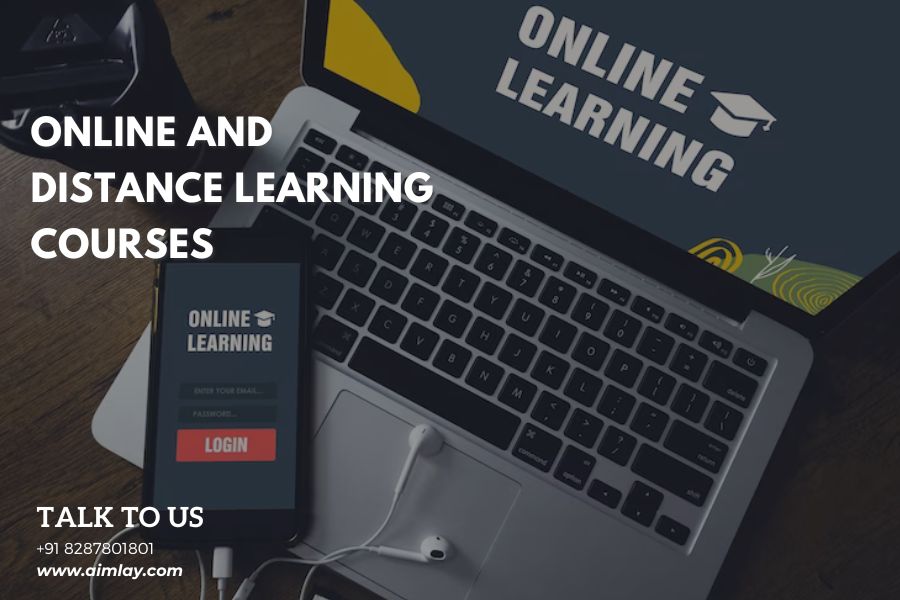In today’s digital era, online and distance learning courses have gained significant popularity as flexible and accessible options for education. These learning modes have revolutionized the traditional classroom setup, allowing learners to pursue their academic and professional goals from the comfort of their homes. In this blog, we will delve into the concept of online and distance learning courses, their advantages and disadvantages, the most popular courses in India, and their role in shaping the future of education.
Table of Content
1. Understanding Online and Distance Learning Courses
2. Advantages of Online and Distance Learning Courses
3. Disadvantages of Online and Distance Learning Courses
4. Most Popular Distance Learning Courses in India
5. Conclusion
6. Frequently Asked Questions
Understanding Online and Distance Learning Courses
Online and distance learning refer to educational programs that utilise digital platforms and technology to deliver instruction to students remotely. These courses break the barriers of time and location, offering flexibility and convenience to learners. Distance learning often involves printed study materials, while online courses primarily rely on internet-based platforms and virtual classrooms.
Online and distance learning have transformed the education landscape by providing flexible and accessible options for students to pursue their academic and professional goals. These courses utilize digital platforms and technology to deliver instruction to learners remotely, breaking down barriers of time and location.
Online and distance learning primarily rely on internet-based platforms and virtual classrooms, while Online learning in higher education often involves printed study materials. Both learning modes offer several advantages that have contributed to their increasing popularity.
One of the critical advantages of online and distance learning is flexibility. Students can access course materials, lectures, and assignments at their convenience. This flexibility allows them to balance their studies with work, family, or other commitments, making education more accessible to a broader range of individuals.
Advantages of Online and Distance Learning Courses
Flexibility: One of the primary benefits of online and distance learning is their flexibility. Students can access course materials and lectures at their own convenience, allowing them to balance their studies with work, family, or other commitments.
Accessibility: These courses eliminate geographical constraints, enabling individuals from remote areas to pursue quality education without needing relocation. It opens doors for individuals who may need help accessing traditional educational institutions.

Self-Paced Learning: Online and distance learning often provide self-paced learning options, allowing students to progress through the curriculum at their preferred speed. Learners can revisit and review course materials as needed, ensuring a personalised learning experience.
Cost-Effectiveness: Distance learning courses typically have lower tuition fees than traditional on-campus programs. Additionally, learners save on transportation, accommodation, and other associated expenses.
Diverse Course Options: Online and distance learning offer various courses across various disciplines, allowing individuals to choose programs that align with their interests and career aspirations.
Disadvantages of Online and Distance Learning Courses
- Limited Face-to-Face Interaction: Unlike traditional classroom settings, online and distance learning courses lack face-to-face interaction with peers and instructors. This may hinder some students’ ability to engage in group discussions, networking and immediately clarify doubts.
- Self-Motivation and Discipline: Distance learning courses require self-motivation and discipline. Students must manage their time effectively and stay committed to their studies without regular classroom schedules and deadlines.
- Technical Challenges: Online courses heavily rely on technology, and technical issues such as internet connectivity problems or software glitches may disrupt the learning experience. Students must be prepared to troubleshoot such issues or seek technical support when needed.
- Limited Hands-On Experience: Some subjects, such as laboratory-based sciences or practical skills training, may be challenging to replicate in an online or distance learning environment. Students pursuing courses in these fields may need hands-on experience.
- Lack of Personalized Attention: In online and distance learning, individualised attention from instructors may be limited due to the large number of students enrolled. Students must be proactive in seeking clarification and support.
Most Popular Distance Learning Courses in India
In India, several Online and distance learning have gained popularity among learners. Some of the most sought-after courses include:
- Bachelor of Commerce (B.Com)
- Bachelor of Arts (B.A.)
- Master of Business Administration (MBA)
- Bachelor of Science (B.Sc.)
- Diploma in Engineering
- Bachelor of Computer Applications (BCA)
- Master of Computer Applications (MCA)
- Diploma in Digital Marketing
- Bachelor of Education (B.Ed.)
- Diploma
Conclusion
Online and distance learning have emerged as flexible and accessible alternatives to traditional classroom-based education. They leverage technology to allow students to pursue their academic and professional goals from any location and at their own pace. These courses are best known for busy working professionals, women and students pursuing multiple courses at once or cannot travel to another city. The world is modernising, so why can’t we?
Download the Online Learning Platform today and Start Learning.
Frequently Asked Questions
Online and distance learning utilize digital platforms and technology to deliver instruction remotely, allowing students to access course materials and lectures at their own convenience. In contrast, traditional classroom-based courses involve physical attendance in a designated location for face-to-face instruction.
Yes, online and distance learning courses can provide a comparable level of education to traditional courses. Reputable institutions design these courses to meet the same academic standards and learning outcomes. However, it is crucial to choose accredited programs and ensure they align with your educational goals.
Online and distance learning courses often incorporate various tools to facilitate student-instructor interaction. These may include discussion boards, virtual classrooms, email communication, video conferencing, and assignment feedback mechanisms. While face-to-face interaction is limited, instructors strive to provide support and engage with students through these digital platforms.
Yes, many employers recognize the value of online and distance learning courses. The reputation and accreditation of the institution offering the course play a significant role in how employers perceive these credentials. It is advisable to research the institution’s reputation and industry recognition before enrolling in a specific program.
Staying motivated and managing time effectively is crucial in online and distance learning. Students can create a study schedule, set goals, establish a dedicated study space, minimize distractions, and practice self-discipline. Engaging in regular communication with instructors and fellow students, participating in discussion forums, and seeking support when needed can also help maintain motivation and accountability.



